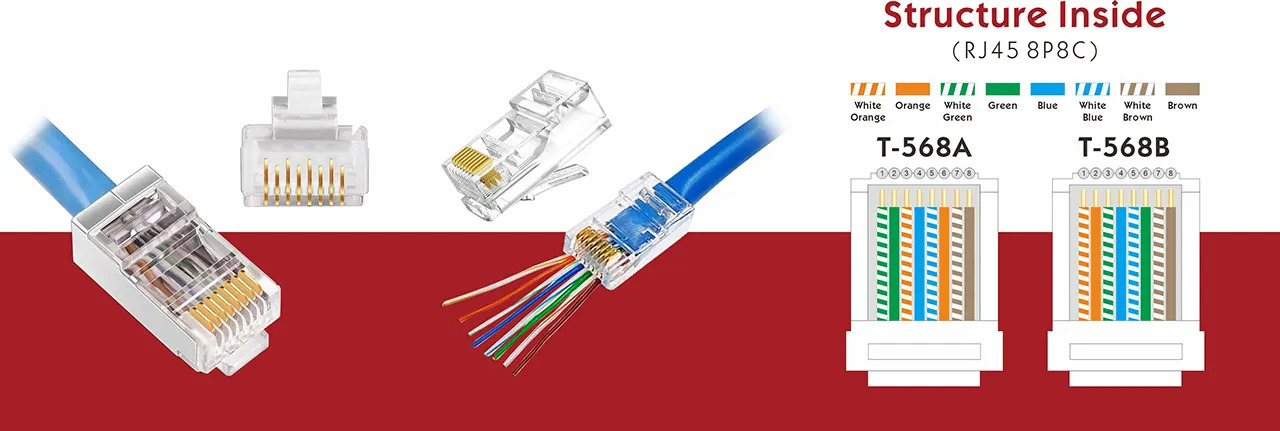Cable & Wire | High quality and excellent service at reasonable prices.
info@zion-communication.com
Author: Michael Publish Time: 04-08-2025 Origin: Site
The RJ45 coupling devices are the primary workhorses in today's Ethernet networking setups. The RJ45 connector is mostly wired with twisted pair cables, which transport data between devices. No matter whether you are linking devices in your home, planning a system at a data center, or using automation at industrial levels, having a good knowledge about the different kinds of RJ45 cables and their application will always be good for ensuring the quality of the signals and also the long-term reliability.
RJ45 is a standardized 8-position, 8-contact (8P8C) modular plug. It is a type of 'registered jack' (RJ) designated explicitly for Ethernet networking. The RJ45 serves as the hardware interface for all future communication over Ethernet from the cables to the equipment being connected, including switches, routers, and patch panels.
The RJ45 connects these with CAT5e, CAT6, CAT6A, CAT7, or CAT8 twisted-pair cables, allowing high-speed data transfer in Local Area Networks.

The RJ45 connectors can be classified based on several criteria:
Category | Frequency | Max Speed | Use Case |
Cat5e | Up to 100 MHz | 1 Gbps | Office networks |
Cat6 | Up to 250 MHz | 1 Gbps (10 Gbps short) | Structured cabling |
Cat6A | Up to 500 MHz | 10 Gbps | Data centers, PoE++ |
Cat7 | Up to 600 MHz | 10 Gbps | EMI-sensitive environments |
Cat8 | Up to 2000 MHz | 25G/40G | High-speed data centers |


Unshielded Twisted Pairs (UTP) – Significant deployment in noise-free areas.
Shielded Twisted Pairs (FTP/STP) – Application of foil or braid shielding which concedes to EMI reduction.
S/FTP – The highest degree of shielding against EMI: every pair and the entire cable are individually shielded.
Standard Plug – The conventional 8P8C head for solid wires and stranded cables.
Pass-Through Plug – Slides off conductors for user-friendliness regarding field terminations.
Short Plug – Small package for patch panels with a high density of connections.
Three-piece Plug – Incorporates the loading bar and shield at the bottom for a better contact.
Toolless Plug – IDC style, field-installable without any toolsets.

Round Cable Support – Featuring the compatibility with the round cable.
Flat Cable Support – Providing the competent support for flat cables.
Oversized OD Support – For the shielded or industrial quality cables.

Category | Type | Description | Typical Use |
By Performance Category | CAT5E RJ45 Connector | Supports up to 100 MHz, suitable for Gigabit Ethernet | Office networks, legacy installations |
CAT6 RJ45 Connector | Supports up to 250 MHz, improved crosstalk performance | Structured cabling, Gigabit networks | |
CAT6A RJ45 Connector | Supports up to 500 MHz, 10 Gigabit Ethernet | Data centers, PoE++ applications | |
CAT7 RJ45 Connector | Supports up to 600 MHz, shielded by default | High-EMI environments, backbone links | |
CAT8 RJ45 Connector | Up to 2000 MHz, short distance 25/40G Ethernet | Server racks, ultra-high-speed links | |
By Shielding Type | Unshielded (UTP) | No metal shielding, lighter and cheaper | Low-interference environments |
Shielded (FTP/STP) | Foil or braided shield, reduces EMI | Industrial areas, data centers | |
Fully Shielded (S/FTP) | Individual & overall shielding | Maximum interference protection | |
By Structure/Form Factor | Standard Crystal Head | Traditional 8P8C plug for solid/stranded cable | General-purpose Ethernet termination |
Short Plug / Compact Head | Shorter body for limited spaces or flat cables | Slim patch panels, dense environments | |
Pass-Through Plug | Conductors pass through for easier termination | Field termination, visual inspection | |
Three-piece Plug | Includes load bar & shield piece for stable contact | High-specification or OEM cabling | |
Toolless Plug | IDC-style, no crimping tool needed | Field-installation convenience | |
By Cable Compatibility | Round Cable Compatible | Designed for circular jacket cables | Most installations |
Flat Cable Compatible | Suitable for flat ribbon-style cables | Under-carpet or flat runs | |
Oversized OD Support | For large-jacket cables (e.g. with braid+foil) | Outdoor shielded cable | |
By Tail Design | With Fix Tail Clamp | Prevents cable slip, improves mechanical stability | Long-term fixed installations |
Without Tail Clamp | Standard plug design, quicker termination | Patch cables, indoor use | |
By Gold Plating | Standard Gold-plated (e.g. 3μ/6μ) | Basic corrosion resistance | General office use |
Heavy Gold-plated (e.g. 50μ) | Enhanced conductivity & durability | High-frequency, high-cycle use |

Feature | Benefit |
Gold-Plated Contacts | Corrosion resistance and better conductivity |
Fix Tail Clamp | Enhanced cable strain relief and mechanical strength |
Shielding | Reduces signal interference in noisy environments |
Compatibility with PoE / PoE+ / PoE++ | Ensures power and data over the same cable |
Easy Termination Design | Reduces installation time and error rate |
■ How to Choose the Right RJ45 Connector?
While buying RJ45 connectors, give thought to the listed points:
Cable Category: Pick connectors that are optimally compatible with the cabling system (Cat5e, Cat6, etc.).
Shielding Requirement: Give preference to shielded ones in a noisy environment.
Installation Environment: Fieldwork applications call for compact, tool-free options.
Termination Type: Among the two provided options, pass-through connections guarantee the rapid end connection, while a traditional plug is suitable for an experienced installer.
Gold Plating Thickness: Use up to 50μ" gold plating for cycles more often or critical data links.
RJ45 connectors are more than just plastic plugs—they're precisely engineered devices and components that play an important role in ensuring data transmission quality across the networks. The appropriate RJ45 connector for your application is a good choice in terms of both performance and reliability in Ethernet networks.
■ RJ45 Connectors from Zion Communication.
At Zion Communication, we offer a full range of RJ45 Modular Plugs including:
Cat6 / Cat6A / Cat7 Shielded Modular Plugs
Open the Unit and the additional bypass network configuration.
Gold-plated Three-Piece Modular Plugs
Tool-free compact RJ45 Plugs for installation in the field.
Whether for OEM where connectors need to be integrated with other components or data center testings, our RJ45 connectors deliver performance that is stable, fully compatible, and secure terminations.
Contact us for more information

Will is the Copper Cabling Product Manager at Zion Communication,
specializing in the development and marketing of Ethernet cabling solutions.
With extensive industry experience, he is dedicated to delivering high-performance
and reliable cabling products to OEM/ODM clients worldwide.
will@zion-communication.com
+86 -18268007201

